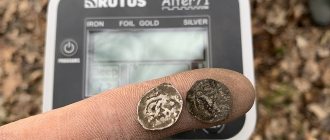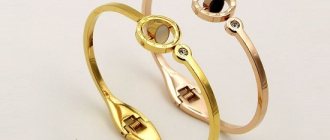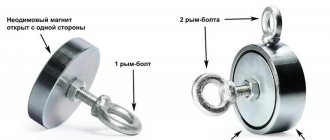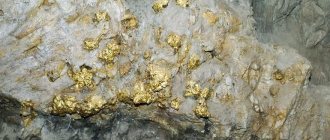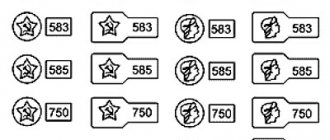You can have significant amounts of money on the back of recycled gold.
However, in order to sell gold items profitably, they still need to be found.
Here, at a minimum, two factors play a role : you need to know where to look and have an appropriate searching unit.
One of the most popular and reliable tools to help a treasure hunter is a metal detector.
What is the best device to choose for searching for gold in land and water, and how it works, we will tell you in this article.
Design and principle of operation
The basic operating principle of a metal detector is based on the ability of metals to conduct electric current. The device emits electromagnetic waves that interact differently with different substances, allowing the detection of highly conductive elements - ferrous and noble metals - in a neutral environment.
Modern models allow adjustment depending on the composition of the soil, the search depth and the characteristics of the objects being sought by adjusting the frequency of the radiation, as well as its nature: constant or pulsed. A metal detector operating at a low frequency is capable of catching a gold item at a great depth - up to 4 meters; high-frequency radiation operates at a short distance, about 40 cm, but it perfectly finds small objects, for example, a ring or a coin.
The metal detector consists of a transmitter coil that generates radiation; a controller that picks up the return signal; power supply; control unit, which allows you to configure the device in accordance with the search conditions.
The design of the device is designed taking into account the specifics of use - the metal detector is carried in the hands for a long time, so its weight and the design of the handle play an important role.
How does this device work?
A metal detector belongs to the group of non-contact search equipment and allows you to detect non-ferrous and ferrous metals at a distance. The operating principle of this device is simple.
In fact,
the two main elements are two coils , one of which emits a signal that affects a certain space in front of it, and the second receives it.
If the signal specified by the first coil finds the desired object, it will be reflected from it and will be received by the second coil.
There is also an electronic device that, based on the recorded signal, converts another detection signal (sound, light, tactile), designed to alert the user about the find.
In addition, the design of the gold mining apparatus includes a power source , which must be selected based on operating conditions - ambient temperature, operating time, etc.
a number of qualitative characteristics in search technology , the presence of which determines the price of the tool and the quality of the work process:
- Sensitivity is the maximum allowable distance at which a metal detector can confidently detect a precious object. In this case, an important factor is the dimensions, weight, and chemical composition of the desired metal.
- Resolution is the ability of an instrument to separate two objects located nearby from each other, forming two independent signals. This indicator is measured by the minimum distance between objects, at which they are defined as two independent objects. The value of the indicator depends on the configuration of the electromagnetic field created by the device itself.
- Maximum search speed - characterizes the permissible speed of movement of the sensitive device of the metal detector relative to the desired surface, at which it will work and maintain sensitivity indicators. Accordingly, the higher the speed of movement relative to the maximum permissible, the lower the likelihood of detecting jewelry.
- Selectivity is the ability to select specific objects with the desired parameters from the general mass of objects, for example, to find a gold earring among metal shavings or household garbage with tin cans. Using this feature of the devices will help save time and reduce the number of recorded signals, effectively detecting items made of precious metals.
- Noise immunity is the ability of a metal detector to maintain the selectivity parameter in the presence of objects in the searched sector that affect the formation of interference.
Advantages and disadvantages
Depending on the principle of operation implemented in a particular model, the metal detector copes better with certain tasks. Built-in functions are important, for example, moisture resistance, estimated search depth, and soil composition in the area where the search is to be carried out.
- Low-frequency metal detectors respond to metal objects in the depths, but only to large ones, such as a barrel of gold.
- High-frequency devices are better suited for searching for small objects at shallow depths.
If we are talking about a device for searching for gold nuggets and sand, then pulse metal detectors respond best to such objects, but, due to their sensitivity, they will be ineffective if there is a lot of small metal debris in the ground.
All of these factors should be taken into account when choosing the best tool for the job.
The best metal detector manufacturers
Models of modern metal detectors differ in many parameters. The very first device that could detect metal objects was developed at the beginning of the 20th century in the USA. It was used to prevent metal objects from being removed from factories. With the development of this industry and the expansion of the scope of application, clear leaders in the production of metal detectors have emerged.
Founder of Garrett Inc. is Charles Garrett, a design engineer in the field of space electronics and seismology. His first invention was a ground metal detector, which had a Hunter coil with a double winding of coaxial cable. The 1984 Olympics brought great fame to the company. The company's engineers made it possible to conduct mass screening of stadium guests - frame metal detectors were created.
One of the largest companies producing devices for electronic soil reconnaissance, Minelab, was founded in 1985 in Australia. Products are manufactured in Malaysia, with representative offices in Ireland and the USA. Since its founding, the company has been developing and improving technologies for detecting metals. The main developer and author of new technological solutions is Bruce Cundy. The company occupies a leading position in the production and sale of metal detectors and their components. The manufacturer is popular among customers for constantly updating its range.
Fisher Research Laboratory was founded in 1931 by Dr. Gerhard Fisher. A native of Germany, he moved to the United States and worked as a development engineer. In 1936, he received a patent for a search device called “Metaloscope”. As the company developed, it opened a modern large plant in California for the development and production of metal detectors. Fisher labs is one of the world leaders in the production of high-tech metal detecting devices.
back to menu ↑
Can any metal detector see gold?
All metal detectors detect the presence of gold within the range of their radiation, but not all are able to accurately recognize the signal. According to the characteristics of changes in the electromagnetic field, gold is similar to rusty iron. Setting up the discrimination function helps eliminate such errors - filtering out interference from metal debris or highly mineralized soil, for example, salty sea sand.
How to look for coins
To search for coins, it is better to purchase a metal detector that allows you to search at high frequencies. The depth of coins, as a rule, is small, and a metal detector, covering a great depth, is not capable of detecting such a small object as a coin.
Tips on finding gold from metal detecting professionals
- you can explore areas where there used to be deposits, for example, Krasnoyarsk or Chita;
- it is important to study information about the places where you plan to search for gold with a metal detector (pay attention to places where there are minerals, granite, shales and gneisses);
- look for traces of gold mining, these can be mine dumps, blocks of rocks that have fallen on the way, mines and holes in the ground;
- You need to look for gold in rivers in depressions that resemble a “pocket”; the nugget can lie in large underwater rocks and their cracks;
- You need to set aside several days for research;
- It is best to look for treasure with a partner for safety reasons;
- a novice seeker must select equipment for the study area, choose appropriate clothing, shoes, a backpack, a pick, a shovel, a tray, etc. (You can use a used metal detector. You should not buy the necessary equipment on aliexpress, it is better to visit specialized retail outlets);
- you should learn how to rinse sand correctly: the tray should not be overloaded; you need to pour out the water carefully, without haste;
- Each zone needs to be worked especially carefully;
- when searching, it is important to take into account river floods, since gold often lies not only near the riverbed, but also beyond it;
- you need to use a professional metal detector for gold;
- smooth pieces doused with water indicate a long stay in water, which means they were brought from distant territories. (You should look for a rough ingot literally under your feet);
- It is best to start research after a flood or flood;
- Not everyone manages to find the treasure right away; it is important to be persistent and go towards your goal.
Types of devices
Manufacturers produce a lot of highly specialized metal detectors that can show the best results when searching for certain objects, when working on difficult soil, or under water, providing the device with the appropriate functions.
- Beach. Beach sand, especially sea sand, is highly mineralized, so to search for valuables on beaches, metal detectors are used, the functions of which are designed to suppress interference that occurs when working on such soil and with manual settings of discrimination parameters.
- Aquatic. For such work, equipment is produced with a sealed housing, which allows searching in high humidity and even under water.
- Deep. Devices capable of operating at low frequencies are suitable here; they are most effective for searching for objects deep underground. A device equipped with two coils is ideal.
Where is the best place to start looking for gold?
If gold-bearing places are far away and there is no way to get there, you can try your luck in nature. People often go to parks, beaches, and also often lose jewelry there. The gold miner will be able to test his equipment and try out different settings and functions. But it is important to remember the legal side of the issue and responsibility.
It is better to study the law and the area before starting research in order to understand what you can do and what is punishable.
Underwater metal detectors often do not have a display and the digger works only by ear
Rating of the most powerful devices and their price
Of course, professional metal detectors, especially those selected in accordance with the task and soil characteristics, will give the best results when searching for precious metals, however, their price will also be impressive.
Minelab Eureka Gold
The metal detector was developed by an Australian company. The price of the device is about 35 thousand, weight is 1950 grams. Copes well with soil rich in minerals. It has three frequency modes – 6.4; 20; 60 kHz, which are switched manually, is capable of finding objects at depth and searching for gold particles smaller than a match head on the surface.
Automatic tuning and a high-precision discriminator with a built-in microprocessor allow you to search without being distracted by frequent reconfiguration of the device.
Garrett At Gold
GPR manufactured by an American company. The cost is in the range of 35-37 thousand rubles. Weighs 1400 grams. The operating search frequency is 18 kHz.
The manufacturer positions this model as a gold detector, capable of distinguishing gold from other metals and finding even small particles. The sealed housing makes it possible to use the device underwater at a depth of up to three meters. There is a function for adjusting soil mineralization.
Nokta Fors Gold
A professional gold mining tool made in Turkey with a wide range of various functions. Costs about 45 thousand rubles. Radiation frequency – 15 kHz, weight 1800 grams.
The metal detector has three modes that allow you to search for valuables in different areas, be it rocky hills or the bank of a stream. Suitable for searching for various metals. The built-in depth indicator will show the exact distance to the target, the Pinpoint function - the device will give a sound signal, which will intensify as it approaches the object. Equipped with a built-in flashlight and vibration mode for night searches.
Minelab GPX 5000
Another model from the category of professional metal detectors from an Australian developer worth 300 thousand. The manufacturer does not indicate operating frequencies. The unit weighs 3.2 kg.
Equipped with an LCD display, it has six built-in search programs, including “fine gold” and “coins/relics”. Depending on the objects being sought and the complexity of the soil, the speed of movement of the metal detector coil is adjusted to optimize searches; there is an adjustable discriminator.
Fisher Gold Bug Pro
A product of a transnational company, costing just over 40 thousand rubles. Highly accurate and versatile, equally suitable for finding small nuggets and gold coins. Weight 1150 grams, operating frequency – 19 kHz. Equipped with a large display, the Pinpoint function and digital identifier of the distance to the target work in all search modes.
Tesoro Lobo Super Traq
American metal detector, sold at a price of about 48 thousand. Radiation at a frequency of 17.5 kHz, weighs 1350 grams. Designed for searching for native gold and jewelry. It has increased sensitivity, has three adjustment modes for soil properties while maintaining high efficiency when searching for small objects.
Price categories of metal detectors
Several factors come into play when it comes to pricing:
- originality of the model - it was made specifically for gold or obtained by increasing the frequency of an existing one;
- marketing - you can hang a “golden” badge on the most ordinary ground metal detector;
- manufacturer's reputation;
- completeness.
Experts distinguish the following price categories for metal detectors:
- Up to 10,000 rubles. As a rule, such metal detectors are not suitable for searching for gold at all.
- Up to 15,000. Very rare models give any decent results. Moreover, there are no high-frequency devices in the range.
- Up to 30,000. You can look for something worthy in this segment, but it’s better to move on to the next one.
- Up to 60,000. In this price range there are already many noteworthy models that meet the requirements for gold metal detectors.
- Over 60,000. There are decent devices. And even very worthy specialized devices.
If searching for gold and coins is a profession, then, of course, it is better to watch segments 4 and 5. Segments 3 and 4 are suitable for amateurs. The first two segments are more likely for fans. To search sporadically, for fun. Or for a targeted search for scrap metal with the aim of selling it.
How to make a metal detector yourself
Even those people who are not particularly good at electronics can make a simple device for searching for gold with their own hands.
Part and workpiece materials
To make a metal detector, you will need a radio, an electronic calculator, a plastic box that will serve as the housing, and double-sided tape. Moreover, both the calculator and the radio should be chosen from those that are worse. The calculator will be a source of radiation, and the receiver will capture its echoes.
What the Law Says About Prospecting for Gold with a Metal Detector
With his own hands, a treasure hunter can find not only wealth, but also problems with the law. The difficulties that amateurs may encounter are set out in Article 243 of the Criminal Code of the Russian Federation “search and (or) removal of archaeological objects from places of occurrence on the surface of the earth, in the ground or under water, carried out without permission (an open sheet), resulting in damage or destruction of the cultural layer" .
What to do with found ancient gold
Russian legislation regarding the activities of treasure hunters is quite confusing. On the one hand, everything that was found in the ground belongs 50% to the state and the same to the finder. But, if the item is more than 100 years old, the seeker has no right to it, since it is government property and should be returned to the owner.
Found gold items
Can you be fined for searching for precious metals with a metal detector in a public place?
There are no penalties for the fact that a person decides to walk around in a public place with a metal detector. But for violation of Art. 243 of the Criminal Code of the Russian Federation, a fine of up to 500,000 rubles or withholding of wages for several years is possible. Punishment is also possible in the form of:
- corrective labor for up to 1 year;
- imprisonment for up to 2 years.
Conducting excavations in places of architectural heritage with “like-minded people” will entail a penalty of imprisonment for up to 6 years.
Mined gold about
Assembly procedure and design
Let's start assembling:
- The receiver is mounted on the inside of the case cover, the calculator on the bottom.
- We set up the receiver: set the volume and AM range to maximum.
- We turn on the calculator, the receiver should respond by making noise. Close the housing cover. The receiver relative to the calculator must be fixed in such a position that the receiver stops picking up interference from the latter. The device is ready for use.
Anyone who understands electronics can assemble a more complex metal detector, the Pirat model. The name is an abbreviation, where pi is the operating principle based on pulsed radiation, and rat is “Radio Cattle,” an abbreviated name for the resource of its developers.
How to use a metal detector correctly
First you need to read the instructions, assemble the metal detector and adjust it to your height. Experiment with it at home.
Equipment setup
The device is also configured according to the instructions, first at home and then in the field. In order to properly configure the device, it is advisable to bury a gold object at a shallow depth and carry out final debugging of the device on it. After this, you can safely start hunting for jewelry. I recommend that you finally watch a video on the topic.
Where to start looking for gold
The most accessible places for any beginner, perfect for the first searches with a metal detector, are beaches. Near almost any settlement there is a suitable body of water with a sandbank. People often lose jewelry in the water, which then washes up on the shore. What if you get lucky and discover a new Klondike.
How to look for gold in the desert
Gold is always where there is water. This rule is also true for the desert. The highest probability of finding gold is in places where there are old river beds or periodic water flows.
Comparison of popular metal detector models
When searching for gold, coins, military relics, antiquities, the main tool is not a shovel, not a special one, but the best metal detector for gold. And the head of a treasure hunter. You can look until you're blue in the face for coin trays in a field where no one has ever set foot, only a tractor has passed by twice - once to plow, and once to mow.
You can buy a sophisticated e-trac, and, without understanding the settings, miss the finds that a thinking digger with an x-terra 505 and a standard DD-coil will pick up for you. Despite the fact that, in theory, a grater is generally not suitable for gold.
Let's leave the lyrics alone, let's move on to popular models that have the word “Gold” in the name. These are, for example, Garrett AT Gold, Makro Kruzer, which also has a modification for gold, Nokta Gold Finder, Fisher Bug DP.
These are devices with different prices and different frequencies, but they are all characterized by excellent separation, high sensitivity to small targets, and fairly high operating frequencies - from 18 and 19 kHz for Garrett and Fischer to 56 and 61 kHz for Turkish athletes.
The Golden Kruzak is also waterproof up to 5 meters.
In theory, the Garrett ATX should rule everyone, unless you don’t mind paying 150,000 rubles for it. It operates on a PI circuit and, perhaps, will be more effective than universal VLF devices.
There is also XP Gold Maxx Power for almost half a million. But the VLF circuit and the operating frequency of 18 KHz seem to hint that there are considerable show-offs behind such a price.
The editors are fully aware that building ratings is a futile task. Finding gold is perhaps the highest treasure hunting skill. Therefore, an understanding person will choose the best metal detector for gold for himself, without being guided by the opinions of others.
